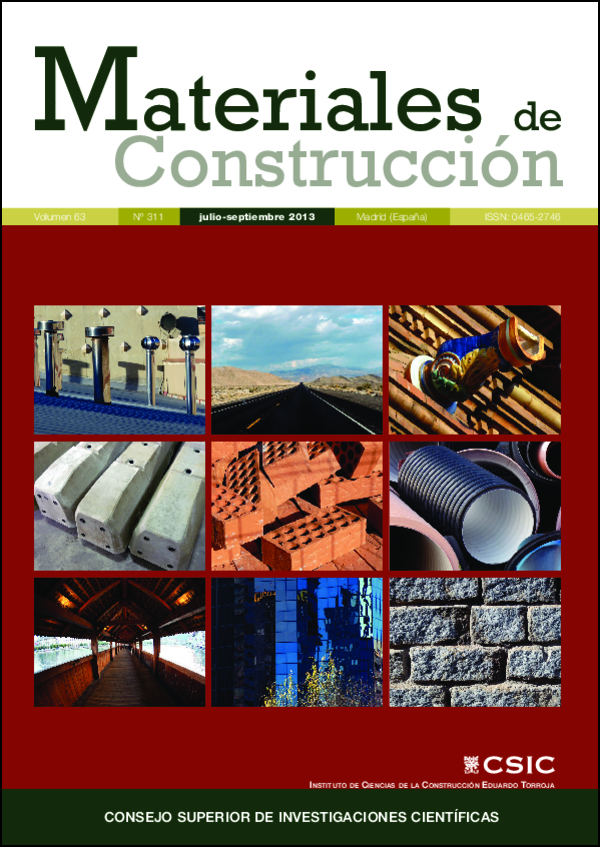Polished Stone Value Test and its relationship with petrographic parameters (hardness contrast and modal composition) and surface micro-roughness in natural and artificial aggregates
DOI:
https://doi.org/10.3989/mc.2013.mc.00912Keywords:
aggregates, wearing course, polished stone value, mechanical and physical propertiesAbstract
The goal of this work was first to establish the relationships between the PSV values and the microstructural and mineralogical features of the aggregates and surface micro-roughness, and then to establish the behavioural differences between natural and artificial aggregates. The results obtained indicate that the surface micro-roughness and the different PSV values of the natural aggregates are strongly governed by the existence of minerals with different degrees of hardness, together with the proportion of these minerals. In contrast, the different degree of porosity in artificial aggregates (a furnace slag) was seen to be responsible for its high surface micro-roughness and PSV values. Finally, the PSV and a petrographic parameter (Overall Hardness Contrast, ΔH) were seen to be related by an exponential curve (PSV=39.726ΔH0.057) with an extremely good fit, providing a good tool to estimate PSVs in natural and artificial aggregates from petrographic parameters.
Downloads
References
(1) Carmona, F., Prendes, N.: "Condicionamientos petrográficos de los áridos en la durabilidad e idoneidad de las capas de rodadura", 1º Congreso Nacional de Áridos. Zaragoza 2006, pp. 251-260.
(2) Lucas, J., Begou, P.A.: "Description de la macrotexture et de la microtexture", Bulletin de liaison des Laboratoires des Ponts et Chaussées, vol. 185 (1993), pp. 63-74.
(3) Ledee, V., Delalande, G., Dupont, P.: "Adhérence et granulats", Bulletin des Laboratoires des Ponts et Chaussées, vol. 255 (2005), pp. 91-116.
(4) Bustillo Revuelta, M, Calvo Sorando, J. P. y Fueyo Casado, L.: Rocas Industriales. Tipología, Aplicaciones en la construcción y empresas del Sector. Editorial Rocas y Minerales. (2001). 410pp.
(5) Gutt, W., Nixon, P.J.: "Studies of the texture of some roadstone materials by scanning electron microscopy", Journal of Materials Science, vol. 7 (1972), pp. 995-1002. http://dx.doi.org/10.1007/BF00550062
(6) Dupont, P., Tourenq, C.: "Granulats et microrugusité", Bulletin de liaison des Laboratoires des Ponts et Chaussées, vol. 185 (1993), pp. 145-151.
(7) Romero, A., Ávila, J. M., Mota, M.I.: "Estudio inicial de la relación existente de los ensayos de CPA y desgaste de los ángeles con la petrografía, aplicada a los áridos silíceos en Extremadura". 1º Congreso Nacional de Áridos. Zaragoza 2006. pp. 277-281.
(8) Smith, M. R. & Collis, L.: Áridos. Áridos naturales y de machaqueo para la construcción (2ª Edición). Geological Society, London, Special Publications, nº 9 (1993). Versión espa-ola L. Suárez y M. Regueiro. Colegio Oficial de Geólogos de Espa-a (1994). 435 pp.
(9) Norma UNE-EN 1097-8: 2000. Ensayos para determinar las propiedades mecánicas y físicas de los áridos. Parte 8: Determinación del coeficiente de pulimento acelerado. Publicada en: Áridos para mezclas bituminosas y tratamientos superficiales de carreteras. AENOR.
(10) Delanne, Y., Goyat, Y.: "Adherencia y seguridad vial". Carreteras, vol. 145 (2006), pp. 100-116.
(11) Forster, S.W.: Aggregate microtexture: profile measurement and related frictional levels. Informe de la Federal Highway Administration FHWA/RD-81/107. FHWA, U.S. Department of Transportation, Washington, D.C. (1981), 36 pp.
(12) Dunham, R.J.: "Classification of carbonate rocks according to depositional texture". En: W.E. Ham (Ed.), Classification of carbonate rocks. Am. Assoc. Petrol. Geol. Mem., vol. 1 (1962), pp. 108-121.
(13) Norma UNE-EN 932-3:1997. Ensayos para determinar las propiedades generales de los áridos. Parte 3: Procedimiento y terminología para la descripción petrográfica simplificada. Publicada en: Áridos para mezclas bituminosas y tratamientos superficiales de carreteras. AENOR.
(14) López-Moro, F.J., Peinado Moreno, M., Gonzalo Corral,J. C., Franco González, P., Rodríguez Alonso, M.D., Fernández Calvo, C. y Payán de Tejada, F. J.: Recursos naturales de Castilla y León para su empleo en capas de rodadura. II Materiales silíceos canterables. Junta de Castilla y León. Consejería de Fomento (1999), 95 pp.
(15) Alonso Castro, E., Franco González, M. P., Gonzalo Corral, J. C., Peinado Moreno, M., Fernández, Calvo, C. y Payán de Tejada, F. J.: Estudio de los Recursos Naturales de Castilla y León para su Empleo en Capas de Rodadura. Junta de Castilla y León. Consejería de Fomento. Documentos Técnicos. (1994), 54pp.
(16) Salinas Rodríguez, J.L.: "El pulimento y el desgaste de Los Ángeles en las areniscas utilizadas como áridos para carreteras". XXIX Congreso Luso-Espa-ol. Lisboa. Asoc. Portuguesa para el progreso de las ciencias (1970). Tomo II, pp. 59-73.
(17) Hartley, A.: "A review of the geological factors influencing the mechanical properties of road surface aggregates". Q.J. Engng. Geol, Vol. 7 (1974), pp. 69-100. http://dx.doi.org/10.1144/GSL.QJEG.1974.007.01.05
(18) Fernández Maroto, G., Suárez del Río, L.M.: "Coeficiente de Los Ángeles y de Pulimento Acelerado de áridos ofíticos de Cantabria: interpretación petrofísica". Mater Construcc., vol. 54 (2004), pp. 53-63. http://dx.doi.org/10.3989/mc.2004.v54.i275.247
Downloads
Published
How to Cite
Issue
Section
License
Copyright (c) 2013 Consejo Superior de Investigaciones Científicas (CSIC)

This work is licensed under a Creative Commons Attribution 4.0 International License.
© CSIC. Manuscripts published in both the print and online versions of this journal are the property of the Consejo Superior de Investigaciones Científicas, and quoting this source is a requirement for any partial or full reproduction.
All contents of this electronic edition, except where otherwise noted, are distributed under a Creative Commons Attribution 4.0 International (CC BY 4.0) licence. You may read here the basic information and the legal text of the licence. The indication of the CC BY 4.0 licence must be expressly stated in this way when necessary.
Self-archiving in repositories, personal webpages or similar, of any version other than the final version of the work produced by the publisher, is not allowed.
















